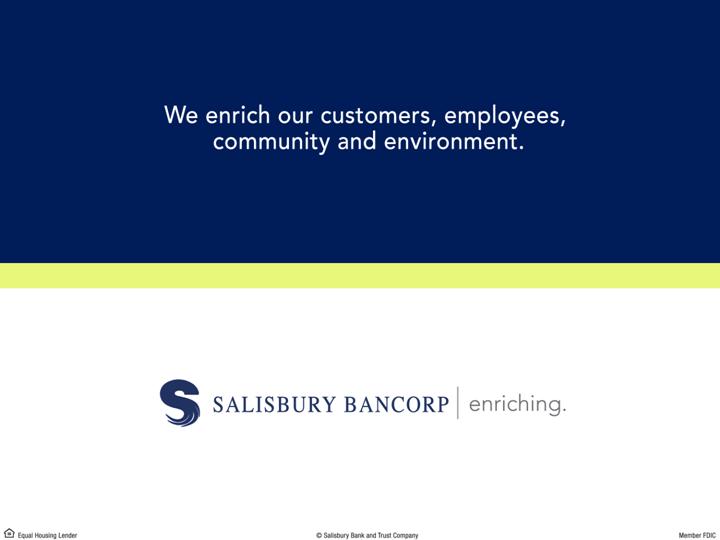Exhibit 99.1
Presentation Materials
John Perotti’s Annual Meeting Speaking Notes (to accompany power point presentation) – May 27, 2009
Slide 1 – Title Slide
Slide 2
FINANCIAL INDUSTRY LANDSCAPE
2008 to Present
The Capital and Credit Market problems that initially surfaced in 2007, triggered by the sub-prime lending debacle, continued in 2008. There were several shocking announcements during the year. It all started on March 24th with JP Morgan Chase announcing their acquisition of Bear Sterns. On June 5th, we learned that Bank of America had reached agreement to acquire Countrywide Financial Corporation.
On July 11th, the Office of Thrift Supervision closed IndyMac Bank in Pasadena, California and the Federal Deposit Insurance Corporation was named conservator. The Bank had total assets of $32 billion and total deposits of $19 billion. Preliminary estimated cost of the resolution to the Deposit Insurance Fund was between $4 and $8 billion. We all can recall the news images of hundreds of people standing in long lines outside of the Bank’s offices.
On September 7th, Federal officials announced an extraordinary takeover of Freddie Mac and Fannie Mae, putting the government in charge of the twin mortgage giants and the $5 trillion in home loans that they backed. The move was Washington’s most dramatic attempt yet to shore up the nation’s housing market which was suffering from record foreclosures and falling prices. This particular announcement had a direct effect on Salisbury Bancorp as the Bank recorded write downs of $2,955,365 on an investment in Freddie Mac preferred stock.
On October 7th, the FDIC announced an increase in deposit insurance coverage to $250,000 per depositor as authorized by the Emergency Economic Stabilization Act of 2008.
On October 14th, the U.S. Treasury Department announced the Troubled Asset Relief Program.
The Federal Reserve Board published a white paper on April 24, 2009. It described the process and methodologies employed by federal banking supervisory authorities in their forward looking assessment (“stress test”) of 19 large U.S. bank holding companies. On May 7th, the Federal Reserve released the results of the stress tests.
Slide 3
SALISBURY BANCORP 2008 Financial Highlights
Salisbury Bancorp’s Net Income for 2008 totaled $1.11 million or $0.66 per share. We ended the year with total assets of $496 million, net loans of $297 million and total deposits of $345 million, representing increases of 7.32%, 11.68%, and 8.56% respectively over year end 2007.
Net Interest Margin was 3.75% and the dividend increased for the 17th consecutive year.
The year before, at December 31, 2007 NIM was 3.54%.
Total Risk Based Capital was 11.59% and Tier One Risk Based Capital was 10.78%.
Return on Average Earning Assets was .24% and Return on Average Equity was 2.52%.
The year before, at December 31, 2007 these were: .85% and 8.50%
Slide 4
SALISBURY BANCORP - March 31, 2009 - Financial Highlights
Based upon the first quarter of 2009, the Company’s Net Income totaled $1.08 million or $0.63 per share. Total assets increased to $506.1 million. Total deposits increased to $366.8 million and net loans increased to $298.3 million.
Slide 5
SALISBURY BANCORP - March 31, 2009 - Financial Highlights
Return on Average Earning Assets is .91%.
Return on Average Equity is 10.34%.
Net Interest Margin has improved to 3.84%.
Slide 6
SALISBURY BANCORP - March 31, 2009 - Financial Highlights
Total Risk Based Capital ratio is 14.55%
Tier 1 Risk Based Capital ratio is 13.66%
Leverage ratio is 9.54%
Slide 7
SALISBURY BANCORP - March 31, 2009 - Financial Highlights
Non Performing Assets were 1.24% of total assets
Net Charge-Offs were $148,885
Allowance for Loan Losses were 1.00% of Total Loans and 47.89% of Non Performing Assets
The year before, at December 31, 2007, our Non Performing Assets were .22% of total assets.
Net Charge Offs were < $1000.
Allowance for Loan Losses were .91% of Total Loans and 246.12% of Non Performing Assets
Slide 8
SECURITIES PORTFOLIO
At March 31, 2009, the Investment Portfolio was valued at $155 million after mark-to-market adjustments. The portfolio provides approximately $1 million in cash flow on a monthly basis.
The primary objectives of the portfolio are to earn interest and dividend income, provide liquidity and manage interest rate risk. It also acts as collateral for deposits of public agencies and advances from the Federal Home Loan Bank of Boston. The Company monitors the market value fluctuations on a monthly basis as well as associated credit ratings to determine potential impairment of a security. The investment portfolio continues to pay principal and interest as scheduled.
Slide 9
STOCK PURCHASE AND DIVIDEND REINVESTMENT PLAN
The Company adopted a Dividend Reinvestment Plan during 2008. The plan enables a shareholder holding a minimum of 25 shares to reinvest all or a portion of their dividends automatically, as well as making additional cash purchases on a quarterly basis. Stock certificates can be deposited into the plan for safekeeping. To become a participant, an enrollment form must be completed and it is a fairly painless process. Visit our website at www.salisburybank.com and click on Shareholder relations to sign up for the Plan or contact our Finance Department. I encourage all of our shareholders to consider this opportunity.
Slide 10
CAPITAL PURCHASE PROGRAM OVERVIEW
On March 13th we sold $8,816,000 of Preferred Stock to the U.S. Treasury Department.
We are a participant in the Capital Purchase Program under the Emergency Economic Stabilization Act of 2008. Although the Bank has capital ratios in excess of those required to be considered “well-capitalized” under FDIC regulations, your board felt it prudent to strengthen our capital position during these uncertain times. These funds provide additional capacity for us to make loans to our customers and also serve as a cushion for greater than anticipated losses. No one can predict with certainty when this recession will subside. Business failures, lay-offs, and reduction or elimination of overtime stipends occur more frequently in a recessionary environment. We have been very proactive managing our loan portfolio and recognizing losses promptly. We are in frequent contact with our borrowers and continue to analyze their financials and visit their businesses to be better able to assess their financial position. Capital is king right now and we are fortunate to have an abundant supply. As soon as we feel it is prudent, we will repay the U.S. Treasury.
Slide 11
TODAY’S ECONOMIC FACTS OF LIFE
Many consumers are afraid. They are spending less and saving more. They are thinking twice about borrowing for anything, other than refinancing their mortgage for a lower fixed rate. States and municipalities are on very restricted budgets. You have to go no further than to look at the condition of the roads in any of the towns in our market area. Needed maintenance is being postponed in many cases due to budget restrictions. Citizens are demanding that towns and municipalities tighten their belts and are expecting flat or decreasing budgets.
Businesses are investing less as sales flatten or decline. There is unprecedented government intervention in everything that we do. Bank margins are tighter than ever. FASB Mark-to-Market accounting rules and Other Than Temporary Impairment Rules require extraordinary due diligence on the part of bank management. FDIC insurance premiums will be a major expense for all banks not only this year, but for the foreseeable future.
Slide 12
FDIC INSURANCE PREMIUMS
Our actual assessment for FDIC insurance in 2008 was $216,002. Our projected expense in 2009 is $734,400. This reflects the cost of increasing federal deposit insurance coverage and the weakened state of the FDIC Deposit Insurance Fund given the magnitude of recent failures nationally.
There were 25 bank and thrift failures nationwide in 2008. There have been 36 thus far in 2009.
FDIC insured institutions reported a net loss of $32.1 billion in the fourth quarter of 2008, a decline of $32.7 billion from the $575 million that the industry earned in the fourth quarter of 2007, and the first quarterly loss since 1990.
Rising loan-loss provisions, large write-downs of goodwill and other assets, and sizable losses in trading accounts all contributed to the industry’s net loss. More than two thirds of all insured institutions were profitable in the fourth quarter, but their earnings were outweighed by large losses at a number of big banks.
Slide 13
MILLERTON BRANCH OFFICE
We have purchased a beautiful location in Millerton and will begin construction of a modern, state of the art, green facility next month at the gateway entrance to the Village on Route 44 at 87 Main Street. This branch will complement our Dover Plains office which is exceeding expectations in both deposits and loans at this time. Eastern Dutchess County is a natural extension of our franchise, and consumers and small business owners in that market appreciate the level of personal service provided by Salisbury Bank.
Slide 14
COMMUNITY ENRICHMENT PROGRAM
We have announced our Community Enrichment Program and pledge not only to maintain, but to increase loans to qualified small businesses, homeowners and other customers in our market area.
Our “Community First” initiative is a first-time home-buyers mortgage loan program that will help encourage credit-worthy renters to take the next step forward. We have committed $5 million to assist qualified first time homebuyers to realize the American dream of home ownership.
We have always supported housing initiatives in our market area but have committed an additional $1 million to support the efforts of the Salisbury Housing Trust and other affordable housing initiatives.
In addition, efforts will be stepped up to provide affordable lending to local municipalities in order to better support the needs of our local communities.
Small businesses are the backbone of our local economy and Salisbury Bank is making a commitment to help businesses in our market prosper and expand, therefore helping to grow jobs in the tri-state area. The Bank’s new BusinessSmart Loan program was created in response to research that showed small businesses have a need for loans up to $50,000 to purchase equipment, upgrade technology and finance other operating needs.
Many of our small business customers have asked for advice, including ways to manage their expenses and cash flows, market their businesses, and create a strong business structure. In response, we have created our BusinessSmart Advisor Program to help guide small businesses through this difficult economic environment.
As a committed corporate citizen, we have always played an active role in supporting community activities. Our “Enriching Fund” commits an additional $20,000 this year to support housing, food and fuel in our market area.
Salisbury Bank University
This isn’t a traditional educational institution - there are no credits to earn, nor exams to pass - but rather this is an initiative to bring vital resources and intelligence to our customers and their communities.
The University is led by a team of employee specialists who have created a monthly seminar/workshop series on timely topics relevant to the needs of small businesses, individuals, and families. Each session is taught by practioners who bring their own first-hand experiences to the classroom. In addition, the Salisbury bank website is being enriched with a special Salisbury Bank University page with resources such as a seminar calendar, a library of financial articles, financial tools, and more.
Salisbury Bank Scholarship Program
The Annual Scholarship Program has been created to assist students who have a proven financial need and who are already making a difference. Four scholarships will be awarded in the amount of $5,000 each to assist students seeking a college degree in a variety of programs. The ideal candidates will be high achievers who are eclectic, have demonstrated leadership experience, show consistent community involvement, and want to make their community a better place.
Slide 15
Tell Us What You Think
Go to www.salisburybank.com, click on shareholder relations, and complete our shareholder survey. We are very interested in your thoughts and your communication will assist us as we strive to be the best that we can be.

Salisbury Bancorp, Inc
May 27, 2009
2009 Annual
Shareholders Meeting

Financial Industry Landscape
2008 to Present
Bear Stearns, Countrywide Mortgage, IndyMac
Bank, Lehman Brothers, Wamu
Fannie Mae and Freddie Mac in receivership
FDIC insurance raised to $250,000
Troubled Asset Relief Program (TARP)
Federal Reserve releases the results of stress tests.
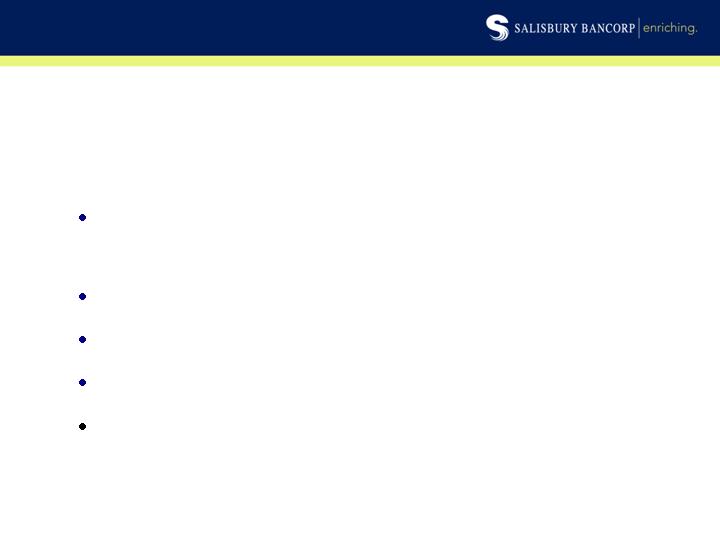
Salisbury Bancorp
2008 Financial Highlights
Net Income:
$1.11 million
$ .66 per share
Assets:
$ 496 million
Net Loans:
$ 297 million
Deposits:
$ 345 million
Increased dividend for 17th consecutive year.
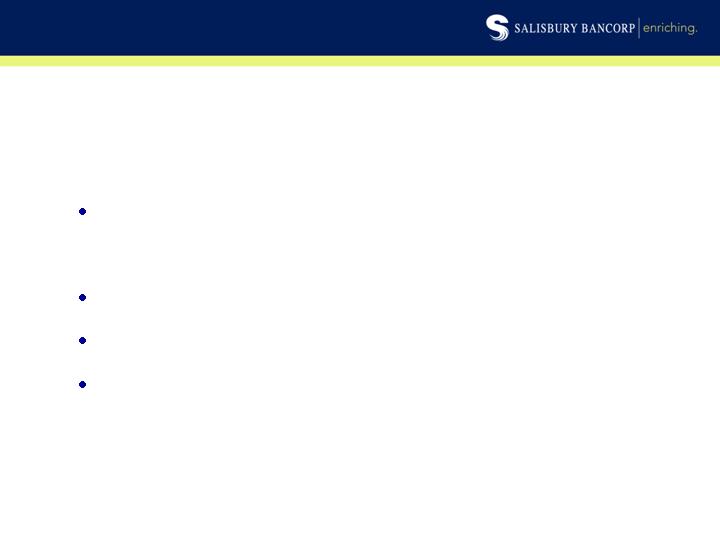
Salisbury Bancorp
March 31, 2009 – Financial Highlights
Net Income:
$1.08 million
$ .63 per share
Total Assets:
$ 506 million
Net Loans:
$ 298 million
Deposits:
$ 367 million
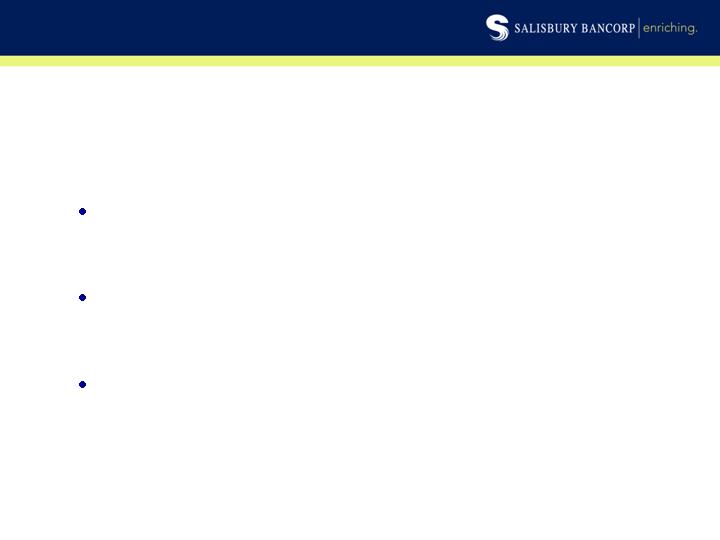
Salisbury Bancorp
March 31, 2009 – Financial Highlights
Annualized
Return on Average Earning Assets
.91%
Annualized
Return on Average Equity
10.34%
Net Interest Margin
3.84%
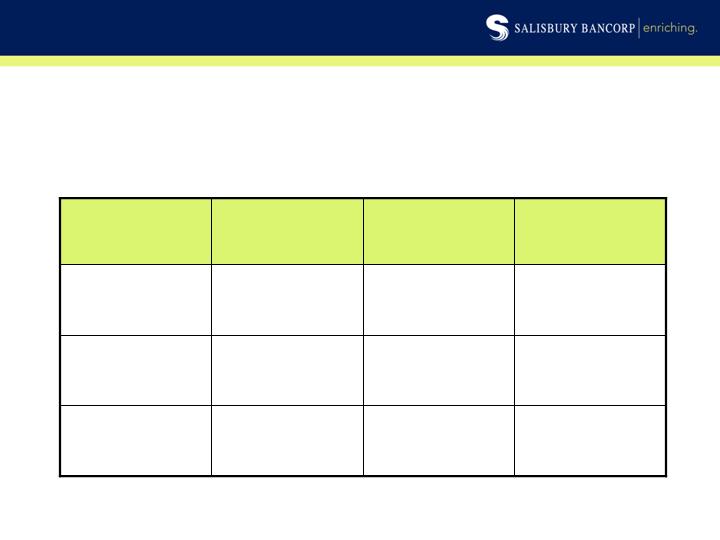
Salisbury Bancorp
March 31, 2009 – Financial Highlights
> 5.00%
9.54%
7.52%
Leverage ratio
> 6.00%
13.66%
10.83%
Tier 1 risk
based capital
>10.00%
14.55%
11.74%
Total risk
based capital
Well
Capitalized
Consolidated
Salisbury Bank
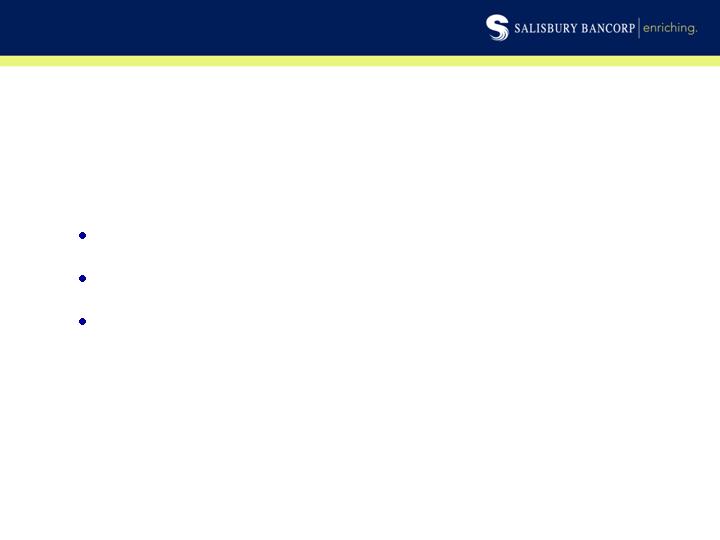
Salisbury Bancorp
March 31, 2009 – Financial Highlights
NPAs
1.24% of total assets
Net Charge-Offs
$148,885
ALL
1.00% of Total Loans
47.89% of NPAs
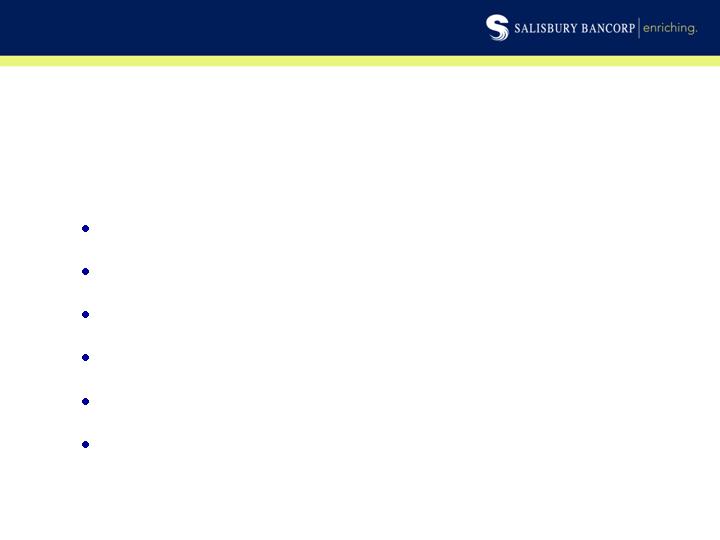
Securities Portfolio March 31, 2009
Investments (at fair market value)
$155 million
Municipal Issues
37.65%
CMOs
20.06%
ARM MBS
19.45%
Agency Issues
16.29%
Fixed Rate MBS
4.80%
Corporate Issues
1.75%
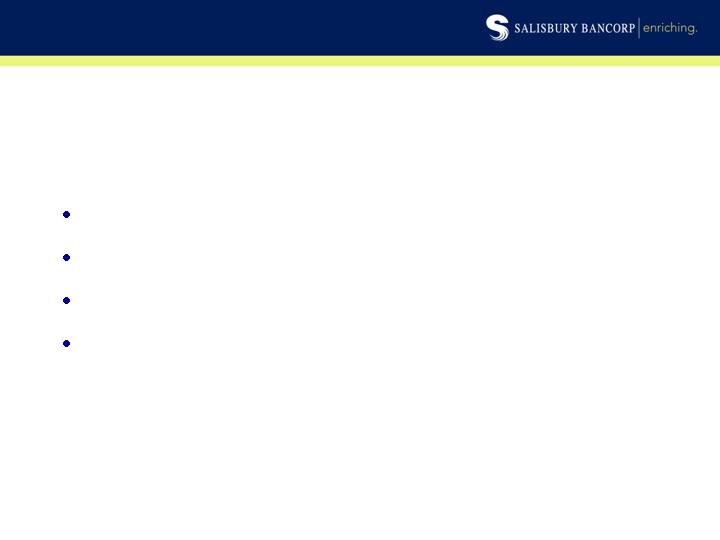
Stock Purchase and Dividend
Reinvestment Plan
Reinvest dividends automatically.
Buy additional shares through the plan.
Certificate safekeeping.
Visit www.salisburybank.com and click on
shareholder relations.
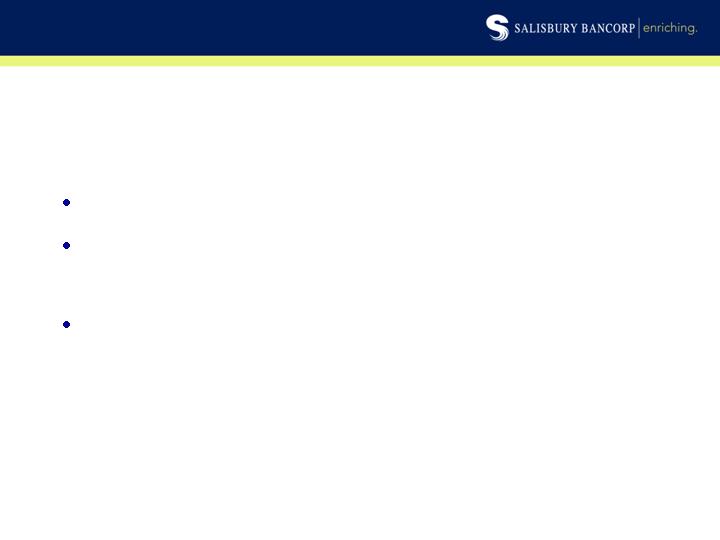
Capital Purchase Program Overview
$8,816,000 capital
Increased TIER 1 Capital at relatively low
cost
Cushion for greater than anticipated losses
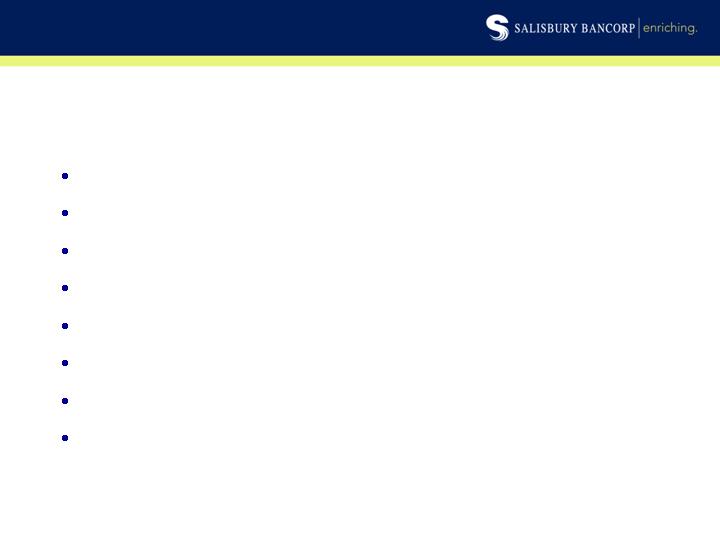
Today’s Economic Facts of Life
Consumers spending less and saving more.
States and municipalities doing the same.
Businesses investing less as sales flatten/decline.
Unprecedented government intervention.
Bank margins tighter than ever.
Mark-to-Market accounting rules.
Other than Temporary Impairment Rules.
FDIC insurance premiums.
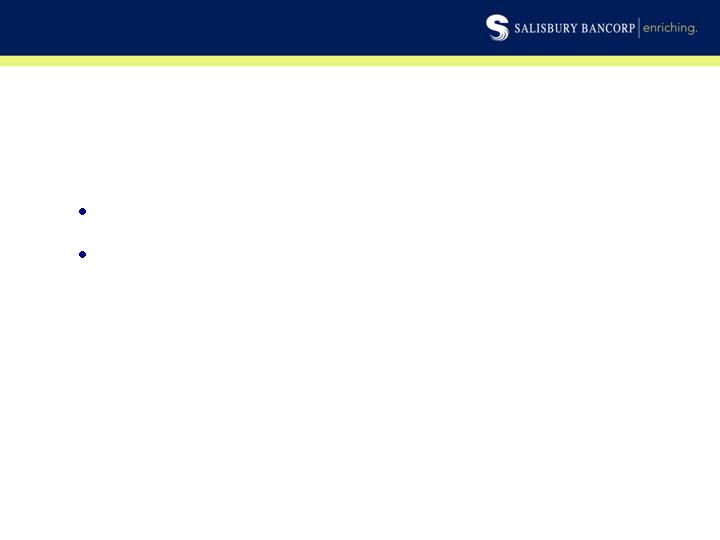
FDIC Insurance Premiums
2008 Actual
$216,002
2009 Budget
$734,440
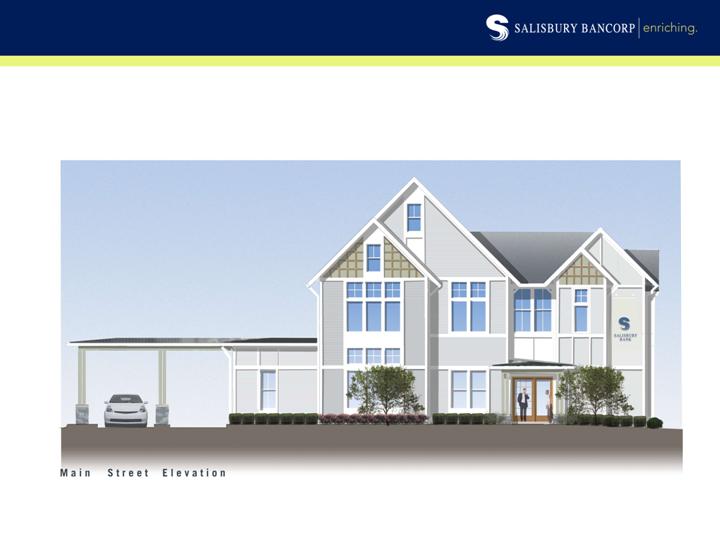
Millerton Branch Office
Opening Fall 2009
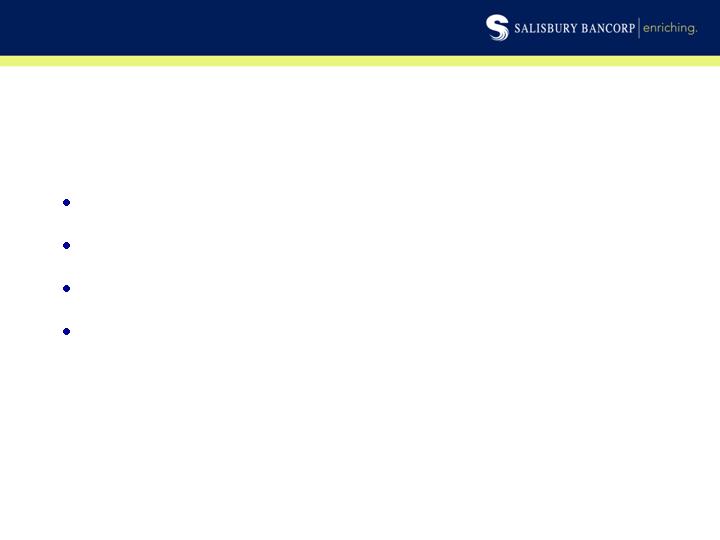
Community Enrichment Program
Enhanced Lending
Enriching Fund
Salisbury Bank University
Scholarship Program
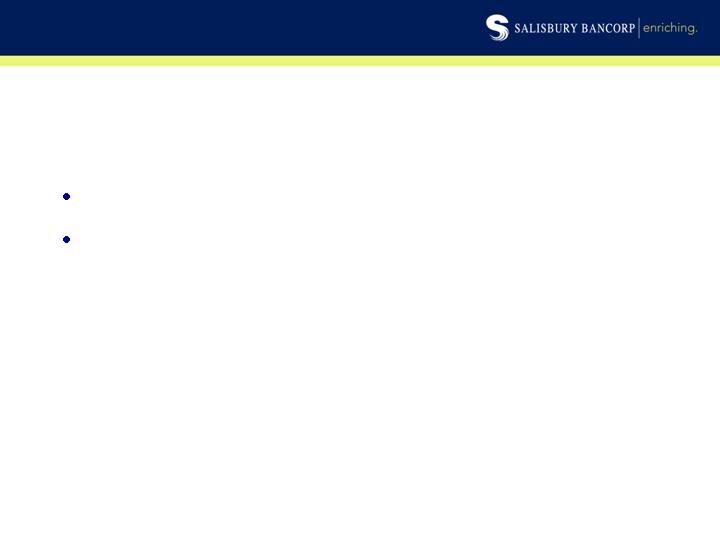
Please tell us what you think.
Shareholder Survey
www.salisburybank.com
click on shareholder relations
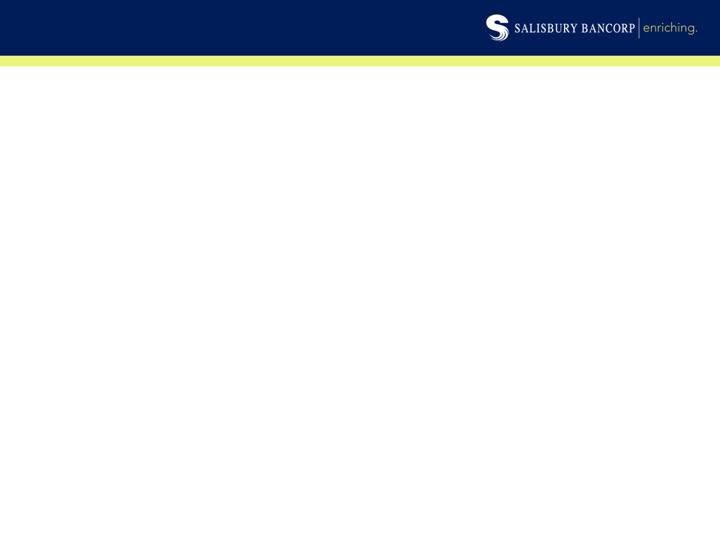
Forward Looking Statements
These materials presented by the Company and the Bank, and oral statements made by executive
officers of the Company and the Bank, may include forward-looking statements relating to such
matters as:
(a) assumptions concerning future economic and business conditions and their effect on the economy
in general and on the markets in which the Company and the Bank do business; and
(b) expectations for revenues and earnings for the Company and Bank.
Such forward-looking statements are based on assumptions rather than historical or current facts and,
therefore, are inherently uncertain and subject to risk. For those statements, the Company claims the
protection of the safe harbor for forward-looking statements contained in the Private Securities
Litigation Act of 1995. The Company notes that a variety of factors could cause the actual results or
experience to differ materially from the anticipated results or other expectations described or implied
by such forward-looking statements. The risks and uncertainties that may effect the operation,
performance, development and results of the Company's and Bank's business include the following:
(a) the risk of adverse changes in business conditions in the banking industry generally and in the
specific markets in which the Bank operates;
(b) changes in the legislative and regulatory environment that negatively impacts the Company and
Bank through increased operating expenses;
(c) increased competition from other financial and non-financial institutions;
(d) the impact of technological advances; and
(e) other risks detailed from time to time in the Company's filings with the Securities and Exchange
Commission.
Such developments could have an adverse impact on the Company's and the Bank's financial
position and results of operations.
